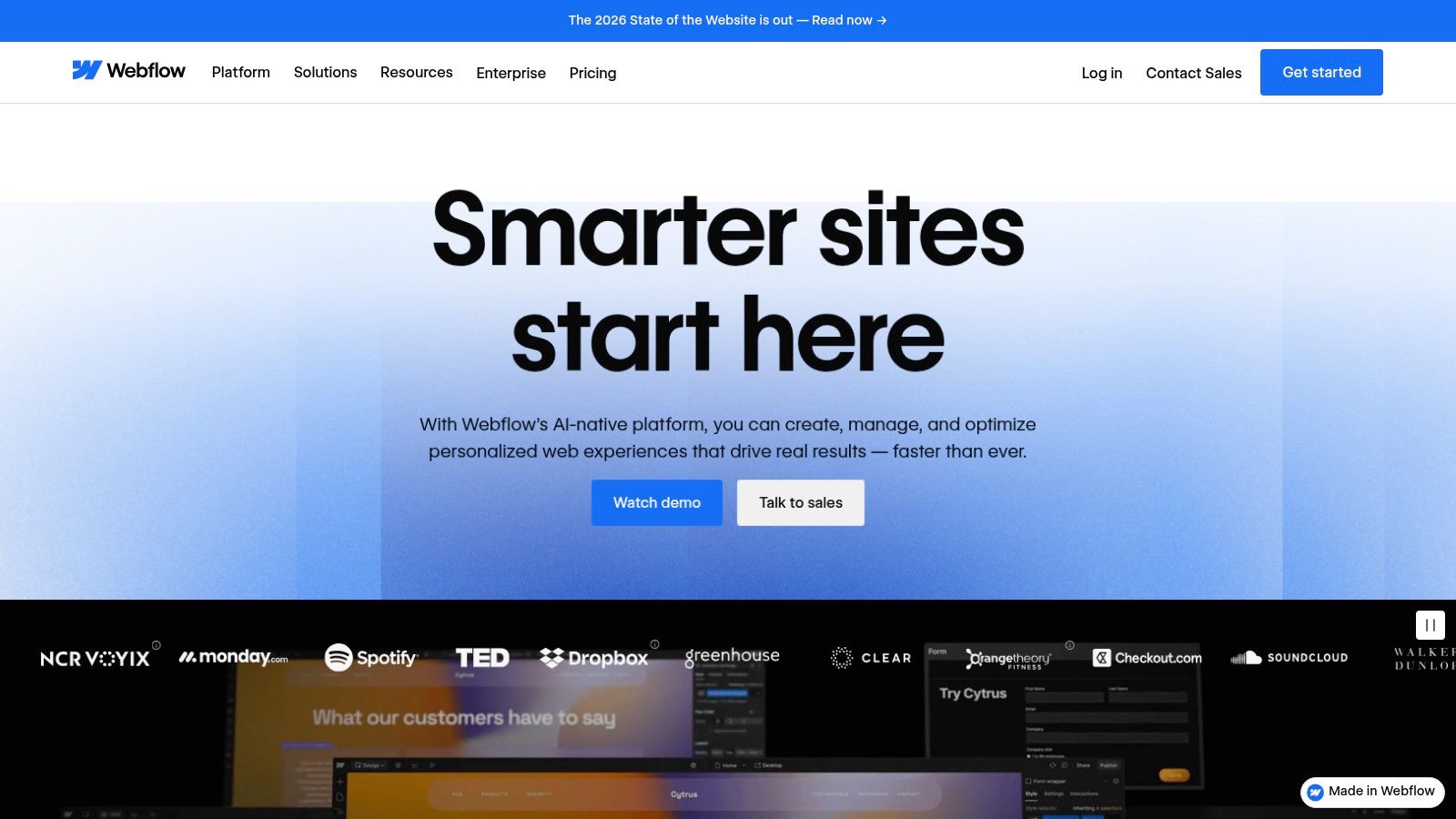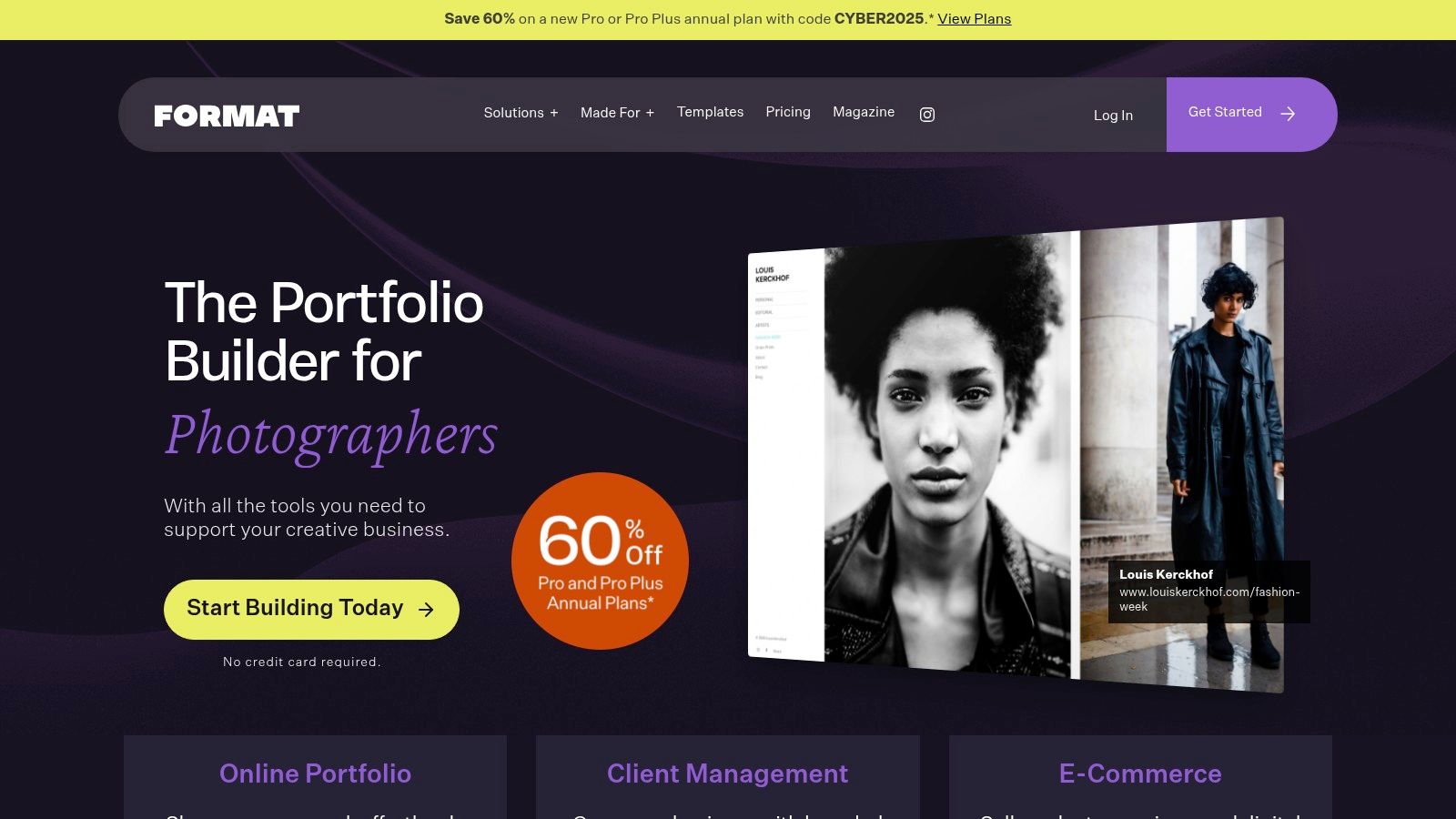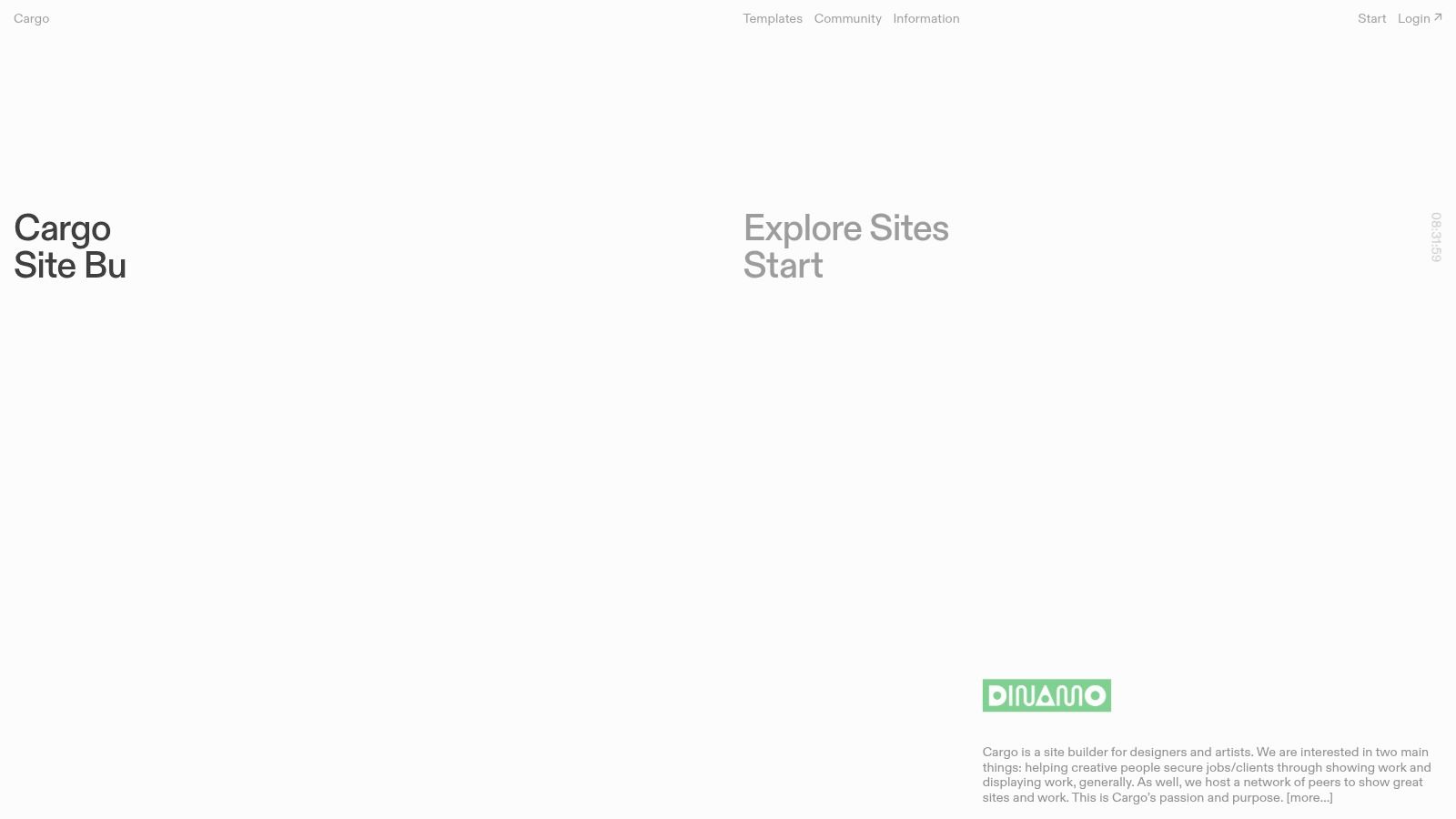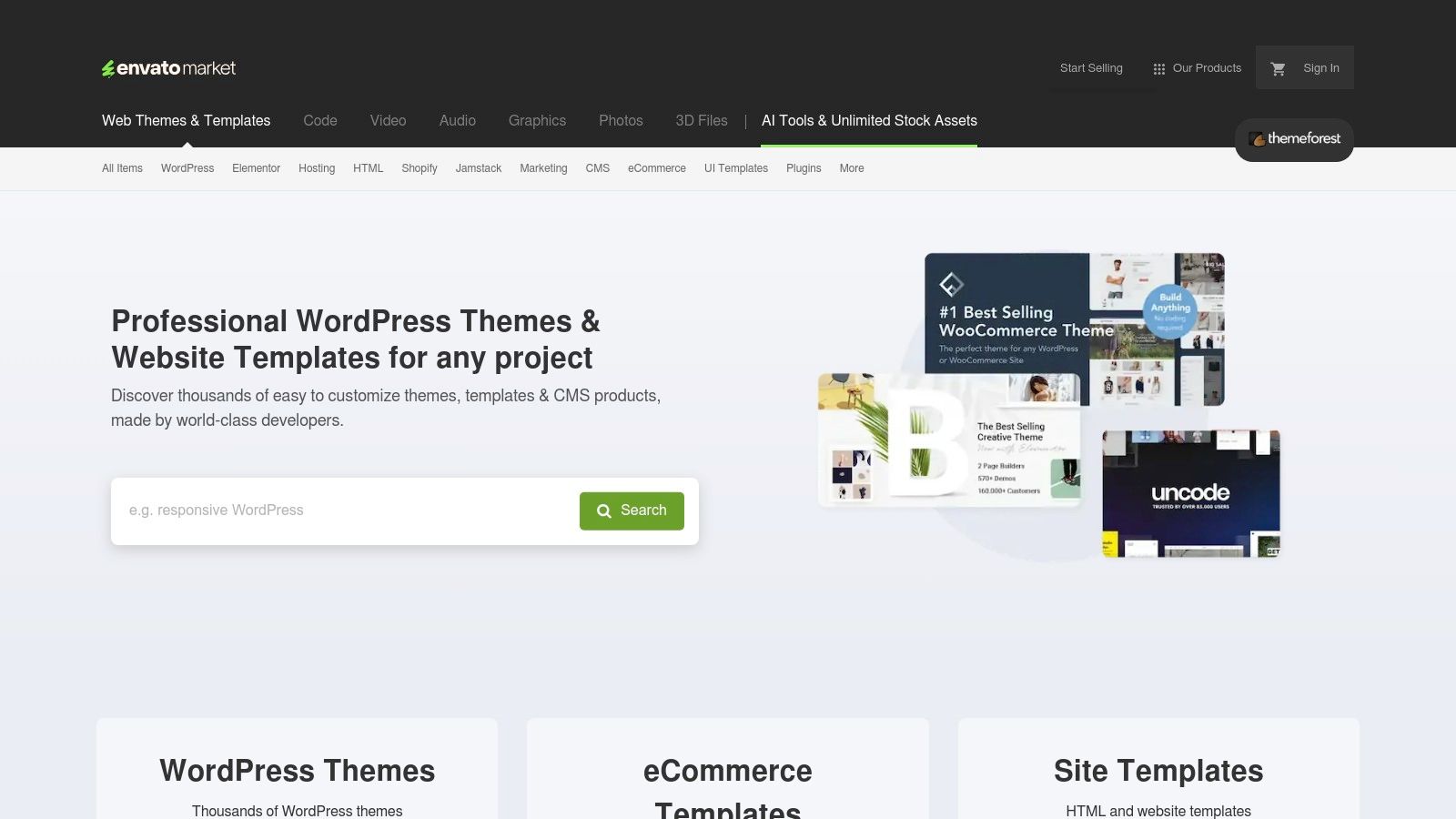Top 7 artists websites examples to spark your portfolio

In a world where clients find you online first, your website is your digital studio. It's not just a gallery of your best work; it's your primary business tool, your booking engine, and your most powerful marketing asset. For beauty professionals like estheticians, hair stylists, and lash artists, an exceptional portfolio is a given. However, a truly effective website must do more than just display your talent-it needs to convert impressed visitors into loyal, paying clients.
Many skilled artists struggle with translating their unique creative vision into a site that actively drives business growth. They often face challenges with search engine optimization (SEO), creating a smooth user experience, and implementing clear calls-to-action that lead directly to bookings. This guide is your solution. We will break down a curated selection of high-performing artists websites examples, looking past the aesthetics to reveal the specific strategies that make them successful. As you refine your own artistic brand for this digital space, it's also worth exploring the critical discussion around AI art versus human art to better articulate your unique value.
Get ready to discover actionable insights and replicable methods. You'll gain a practical playbook to build a website that not only showcases your incredible artistry but also keeps your appointment calendar full. Each example includes screenshots and direct links, so you can see these principles in action.
1. Squarespace: The Epitome of Polished Professionalism
For artists in the beauty industry, from lash technicians to tattoo artists, a visually stunning online presence is non-negotiable. Squarespace has solidified its position as the go-to platform for creating portfolio-centric websites that are as polished as the services you offer. It’s an all-in-one solution that combines a website builder, hosting, commerce, and marketing tools into a single, cohesive package.
This platform stands out among other artists websites examples for its emphasis on award-winning design. The templates feel less like cookie-cutter layouts and more like custom-designed digital galleries, making your work the undeniable star. For a salon, spa, or independent artist, this means you can launch a high-end, professional-looking site without needing to hire a web designer.
Strategic Breakdown
Squarespace’s strength lies in its integrated, user-friendly ecosystem. The interface is intuitive, employing a drag-and-drop editor that simplifies the process of building and updating your site. This is crucial for busy beauty professionals who need to manage bookings, update portfolios, and run marketing campaigns efficiently.
Key Insight: Squarespace removes the technical barriers to a beautiful website. Its templates are mobile-responsive out of the box, ensuring your portfolio looks flawless whether a client views it on their phone or a desktop.
Actionable Takeaways for Artists
To get the most out of Squarespace, beauty professionals should leverage its built-in features strategically. Here are easy-to-follow steps you can implement today:
- Implement Integrated Scheduling: Activate Squarespace Scheduling (formerly Acuity) to let clients book appointments directly on your site. This streamlines your booking process, reduces no-shows with automated reminders, and syncs seamlessly with your calendar.
- Organize Portfolio Galleries: Select a template with a strong focus on visuals, such as "Paloma" or "Utica." Use high-resolution images of your work and organize them into clear categories (e.g., "Lash Lifts," "Balayage," "Microblading") to build an easy-to-navigate portfolio.
- Set Up Built-in Commerce: If you sell aftercare products, gift cards, or merchandise, use the platform’s e-commerce tools. They are robust and simple to set up, creating an additional revenue stream for your business with minimal effort.
Pricing starts at around $16 per month (billed annually), with plans that include e-commerce and scheduling features at higher tiers. The platform's all-inclusive nature, combining stunning design with powerful business tools, makes it an ideal choice for artists who demand both style and substance.
2. Wix: The Ultimate in Creative Customization
For artists and beauty professionals who crave maximum creative control without touching a line of code, Wix offers an incredibly flexible and feature-rich platform. It’s renowned for its powerful drag-and-drop editor, allowing you to place any element anywhere on the page, giving you complete design freedom. This makes it a top contender among artists websites examples for those who want a truly bespoke look.
Wix provides a massive library of hundreds of templates, with many specifically designed for salons, tattoo artists, and portfolio showcases. This vast selection ensures that you can find a starting point that closely matches your brand's aesthetic. From there, the customization options are nearly limitless, empowering you to build a site that is as unique as your artistry.
Strategic Breakdown
Wix’s core strength is its unparalleled flexibility combined with a robust app ecosystem. The Wix App Market allows you to add advanced functionality to your site with just a few clicks, from sophisticated booking systems to tools for selling digital products or prints. This modular approach means your website can evolve and grow alongside your business needs.
Key Insight: Wix puts granular design control in the hands of the user. While Squarespace offers curated polish, Wix provides a blank canvas with powerful tools, ideal for the artist who has a very specific vision for their digital presence.
Actionable Takeaways for Artists
To maximize Wix's potential, beauty and creative professionals should tap into its specialized tools. Here are actionable steps for your business:
- Use the Wix Pro Gallery: This feature provides advanced image settings, including quality control, right-click protection, and various layouts like grids and sliders. Implement this to create a high-impact, professional portfolio that also protects your work from being copied.
- Install the Wix Art Store: If you want to sell prints, merchandise, or digital downloads, add the Wix Art Store app. It streamlines the entire process, handling product display, payment processing, and even printing and shipping through third-party integrations.
- Activate Wix Bookings: This powerful app is essential for any service-based business. Set it up to let clients book appointments, manage their schedules, and pay for services directly through your site. This reduces your administrative workload and automates a key part of your business.
Wix offers a free plan with ads, but professional plans start around $16 per month (billed annually). The ability to add specific functionalities via the App Market makes it a scalable choice for artists who want their website to be a powerful, all-in-one business hub.
3. Webflow: The Designer's Canvas for Creative Control
For artists and studios that crave pixel-perfect precision and complete creative freedom, Webflow offers a powerful alternative to template-based builders. It bridges the gap between simple drag-and-drop editors and complex custom coding, giving you the control of a professional developer without needing to write a single line of code. It’s the ideal platform for creatives who want their website to be as unique and meticulously crafted as their art.

This platform is a standout among artists websites examples because it empowers you to build visually complex, highly interactive experiences. Instead of being confined to a template's pre-set blocks, you can design from a blank canvas, adding advanced animations and interactions that bring your portfolio to life. This makes it perfect for a high-end tattoo studio, a creative agency, or any artist wanting a truly bespoke digital presence.
Strategic Breakdown
Webflow's core strength is its visual designer, which mirrors the tools found in professional design software like Photoshop or Figma but outputs clean, production-ready code. While this means a steeper learning curve than simpler builders, the payoff is unparalleled customization. You gain granular control over every element, from spacing and typography to complex, multi-step animations. For a deeper dive, you can learn more about how to create a professional website with tools like these.
Key Insight: Webflow empowers artists to break free from template constraints. Its powerful CMS (Content Management System) is perfect for managing dynamic content like artist portfolios, blog posts, or event listings with sophisticated filtering and sorting capabilities.
Actionable Takeaways for Artists
To harness Webflow's full potential, here are some actionable steps for your business:
- Incorporate Advanced Animations: Use the Interactions panel to create subtle hover effects on your portfolio images, parallax scrolling on your "About" page, or engaging page-load animations. This simple touch adds a layer of professional polish that captivates visitors.
- Organize with the CMS: Create "Collections" for different categories of your work (e.g., "Fine Line Tattoos," "Color Realism," "Flash Sheets"). This allows you to design one template page that dynamically updates with every new piece you add, keeping your portfolio organized and easy to manage.
- Clone Projects from the Showcase: Explore Webflow's Showcase, a library of projects built by other users. Find a "cloneable" project you admire and use it as a professional starting point for your own design, saving you significant time.
Pricing for a site plan starts at around $14 per month (billed annually), with CMS and E-commerce plans at higher price points. While it demands a greater initial time investment, Webflow is the ultimate tool for artists who refuse to compromise on their digital vision.
4. Format: The Artist-Centric Portfolio Builder
For visual artists like illustrators, photographers, and tattoo designers who need a portfolio that's all about the art, Format offers a purpose-built solution. Unlike general-purpose website builders, Format is engineered from the ground up for creatives. It strips away unnecessary complexity to provide a streamlined platform where presenting, selling, and delivering your work is the primary focus.

This platform is a standout among artists websites examples because it understands the creative workflow. Features like private client galleries, commission-free art stores, and seamless file transfers are integrated directly into the dashboard. This design philosophy means an artist can manage their entire online presence, from initial portfolio showcase to final client delivery, without juggling multiple services. For more inspiration, check out these other examples of online portfolios.
Strategic Breakdown
Format’s core advantage is its specialization. While other builders aim to serve everyone, Format’s features are tailored to solve the specific problems artists face. The user interface is clean and intuitive, designed to get your portfolio online quickly with templates that prioritize large, high-resolution imagery and minimalist navigation.
Key Insight: Format centralizes the artist's business needs. By combining a portfolio, a commission-free store, and client-proofing galleries in one place, it simplifies your tech stack and lets you focus on creating.
Actionable Takeaways for Artists
To maximize Format’s potential, implement these business-focused strategies:
- Set Up Client Galleries: Use password-protected client galleries for tattoo design proofs or permanent makeup consultations. This provides a professional, private space for clients to review concepts, provide feedback, and approve final designs before their appointment.
- Launch a Commission-Free Store: Easily sell prints, merchandise, or digital products directly through your site. Because Format doesn't take a commission on most plans, you keep more of your revenue. This is a perfect way for tattoo artists to sell flash sheets or for estheticians to sell branded aftercare kits.
- Use the Lightroom Integration: If you're a photographer or visual artist using Adobe Lightroom, install the plugin to sync photo galleries directly to your Format portfolio. This automates updates and saves significant time when adding new work to your website.
Pricing starts at $8 per month (billed annually) for the Basic plan, with Pro and Pro Plus plans offering expanded features like larger stores, more client gallery storage, and advanced tools. For the solo artist or small studio prioritizing a stunning visual showcase and efficient client management, Format is a powerful, focused choice.
5. Cargo: The Experimental Creative Playground
For artists who see their website as an extension of their creative practice, Cargo offers a refreshing alternative to mainstream builders. This platform is favored by visual artists, designers, and creative studios for its distinct, often experimental, template styles that prioritize artistic expression over corporate polish. Cargo operates with a simple, indie-friendly ethos, providing powerful tools without the bloat of larger platforms.
This builder is a standout in the list of artists websites examples because it champions a unique, gallery-like aesthetic. Its templates feel less like business websites and more like digital exhibitions, making it perfect for tattoo artists, avant-garde stylists, or beauty professionals whose work blurs the line into fine art. The focus is purely on showcasing visuals in a clean, impactful, and often unconventional way.

Strategic Breakdown
Cargo’s strength is its minimalist approach combined with a powerful, flexible backend. The platform allows a single account to publish multiple public sites, an ideal feature for creating separate portfolios, one-off project showcases, or digital lookbooks for special collections. This flexibility is built for creatives who think in projects, not just in static portfolios. While it has a smaller template library, each one is highly curated to offer a strong creative point of view.
Key Insight: Cargo empowers artists to treat their web presence as a dynamic creative space. The ability to launch multiple sites from one account encourages experimentation and project-specific presentations without extra cost.
Actionable Takeaways for Artists
To make the most of Cargo’s unique ecosystem, here are some actionable steps for your business:
- Build Project Microsites: A tattoo artist can launch a separate, temporary microsite for a flash sheet event, a guest spot, or a new style they are developing. This keeps the main portfolio clean while allowing for focused marketing campaigns.
- Choose Minimalist Templates: Select a template that uses bold typography and generous white space. This makes your high-quality photos of intricate nail art or detailed tattoos the hero of the page. The goal is to avoid clutter and let your work speak for itself.
- Add the Commerce Feature: For a flat fee, you can add a simple shop to sell prints, merchandise, or digital products like tattoo vouchers. This is a straightforward, low-cost way to generate sales directly from your portfolio.
Cargo offers a simple flat pricing model at $199 per year (or $24 per month), which includes the ability to create unlimited sites and a commerce add-on. Its artist-centric philosophy and unique features make it the perfect choice for creatives who want their website to be as distinctive as their work.
6. Adobe Portfolio: The Creative Cloud Companion
For artists already embedded in the Adobe ecosystem, from graphic designers crafting salon logos to tattoo artists sketching on an iPad, Adobe Portfolio is a seamless extension of their creative workflow. It’s a portfolio-building tool included at no extra cost with most Creative Cloud subscriptions, designed to get your work online quickly and elegantly. It removes the friction between creating and showcasing.
This platform is a standout choice among artists websites examples for its direct integration with Behance and Adobe apps. Instead of exporting, uploading, and arranging, you can sync your projects directly from Lightroom or Behance into a clean, professional-looking portfolio. For a busy artist, this means less time spent on website administration and more time focused on their craft.
Strategic Breakdown
Adobe Portfolio’s core strength is its simplicity and integration. It's not trying to be an all-in-one business hub; it's a dedicated tool for showcasing creative work. The setup process is incredibly fast, allowing an artist to select a theme, sync their projects, customize a few details, and publish in a fraction of the time required by more complex builders.
Key Insight: Adobe Portfolio prioritizes speed and convenience for existing Creative Cloud users. It transforms your Behance profile or Adobe Cloud folders into a polished, custom-domain website with just a few clicks.
Actionable Takeaways for Artists
To get the most out of Adobe Portfolio, implement these simple, time-saving actions:
- Activate Behance Sync: Create projects on Behance to gain visibility within its massive creative community. Then, use the one-click import feature to pull those projects directly into your Adobe Portfolio site. This tactic saves you from uploading your work twice.
- Use Photo Grid Layouts: Choose templates like "Matthias" or "Lina" that feature dynamic photo grids. These are perfect for creating visual-heavy galleries for services like nail art or cosmetic tattoos, letting potential clients see the breadth of your work at a single glance.
- Create Password-Protected Pages: Use password protection to create private galleries for specific clients. A tattoo artist can use this to share a custom design draft, or a makeup artist can share a private album from a wedding trial, adding a professional and exclusive touch to the client experience.
Access is included with most Creative Cloud plans, which start at around $9.99 per month for the Photography plan. While it lacks native e-commerce or booking tools, its value for artists already paying for Adobe software is undeniable, making it one of the most cost-effective and efficient ways to build a stunning portfolio.
7. ThemeForest (Envato Market): The Customizer's Toolkit
For artists who want complete control over their digital presence and are comfortable with a more hands-on approach, ThemeForest is an indispensable resource. It’s a massive marketplace where you can purchase pre-designed website themes, primarily for self-hosted WordPress sites, giving you the foundation for a truly custom online portfolio. Unlike all-in-one builders, ThemeForest provides the creative assets, leaving the hosting and setup to you.
This platform offers one of the most diverse collections of artists websites examples in the form of purchasable templates. For a tattoo artist seeking a dark, edgy design or a lash technician wanting a light, airy aesthetic, the sheer volume of options ensures you can find a theme that perfectly matches your brand's unique vibe. This approach is ideal for professionals who want the look of a custom site without the five-figure price tag.

Strategic Breakdown
ThemeForest’s primary strength is its unparalleled variety and specialization, empowering artists to build a website with specific functionalities from the start. Since you own the theme file and host the site yourself (typically on WordPress), you have full ownership and are not locked into a specific platform's ecosystem. This freedom allows for limitless customization and scalability as your business grows.
Key Insight: ThemeForest decouples design from the platform. It provides the aesthetic and functional blueprint, giving you the freedom to choose your own hosting and plugins for a website that is truly yours.
Actionable Takeaways for Artists
To successfully use ThemeForest, business owners need to be strategic. Follow these steps for the best results:
- Vet Your Theme Before Buying: Don't just look at the live demo. Check the theme's sales count, user ratings, and the date of its last update. A well-supported theme is crucial for security. Read the comments to see if the author is responsive to support questions.
- Check for Bundled Plugins: Many themes include premium plugins like Slider Revolution for galleries or page builders like Elementor. Choosing a theme with these included can save you over $100 in extra costs and make customization much easier.
- Confirm Booking System Compatibility: Before purchasing, ensure the theme is fully compatible with popular WordPress booking plugins like Amelia, Bookly, or Simply Schedule Appointments. Check the theme’s sales page for confirmed compatibility to avoid future technical issues.
Themes are typically a one-time purchase, often ranging from $30 to $80, which includes six months of author support. While it requires more initial setup than an all-in-one builder, ThemeForest offers a powerful, cost-effective path to a highly personalized and professional artist website.
Artist Website Builders — 7-Point Comparison
| Platform | Implementation complexity 🔄 | Resource requirements ⚡ | Expected outcomes ⭐📊 | Ideal use cases 💡 | Key advantages |
|---|---|---|---|---|---|
| Squarespace | Low — template-driven; minimal setup, some code for advanced tweaks | Subscription with hosting/SSL; possible transaction/digital‑product fees on lower tiers | High — polished, gallery‑quality sites; reliable uptime and analytics | Artists needing a fast, polished portfolio with built‑in selling | Designer templates, integrated hosting/support, marketing tools |
| Wix | Low–Medium — drag‑and‑drop; flexible but can become complex with many apps | Subscription; wide app marketplace (add‑on costs can add up) | High — many ready‑made styles and strong gallery/store options | Creators who want many templates, apps and easy e‑commerce scaling | Huge template library, flexible editor, app ecosystem |
| Webflow | Medium–High — visual, designer‑grade controls; steeper learning curve | Higher pricing for CMS/e‑commerce; more design time required | Very High — pixel‑level control, advanced animations and robust CMS | Designers and studios needing precise layouts and complex portfolios | Precise design control, powerful CMS, scalable for studio sites |
| Format | Low — purpose‑built portfolio workflows; simple launch | Subscription; fewer third‑party integrations but includes client tools | High for presentation — clean, artwork‑forward templates; limited commerce by plan | Photographers/illustrators valuing presentation and client delivery | Client galleries, Lightroom integration, commission‑free store options |
| Cargo | Low — simple editor with experimental templates; easy to publish multiple sites | Flat, inexpensive pricing; optional commerce add‑on | Medium — distinct, exhibition‑style sites; good for multiple microsites | Indie artists and studios creating multiple project/exhibition sites | Multiple sites per account, unique aesthetics, straightforward pricing |
| Adobe Portfolio | Very Low — one‑click projects from Behance; simple theme choices | Included with most Creative Cloud plans (no standalone plan) | Medium — clean portfolios with Behance discoverability; limited commerce | Creative Cloud subscribers who want a fast, no‑extra‑cost portfolio | Behance/Adobe integration, quick setup, hosting included |
| ThemeForest (Envato) | Medium — requires theme installation and (usually) self‑hosted setup | One‑time theme purchase + separate hosting/maintenance costs; variable support | Variable — wide stylistic choices; outcome depends on theme quality and maintenance | WordPress users seeking ownership and a large selection of designs | Massive theme catalog, competitive prices, many WooCommerce/creative options |
From Inspiration to Implementation: Your Next Steps
We've explored a diverse landscape of stunning artists websites examples, each built on platforms with unique strengths. From the intuitive drag-and-drop interface of Wix to the structured elegance of Squarespace and the custom design freedom of Webflow, the possibilities are vast. The core lesson is clear: an effective website is more than a digital gallery; it's a strategic business tool designed to attract your ideal client and drive growth.
The most successful websites we analyzed share a common foundation. They combine compelling visuals with clear calls-to-action, intuitive navigation, and a seamless booking process. They don’t just display art; they tell a story, build a brand, and convert visitors into loyal customers. Your website should function as your most dedicated employee, working around the clock to showcase your talent, secure appointments, and solidify your professional presence.
Translating Inspiration into Action
Feeling inspired is the first step, but turning that vision into a reality requires a plan. Let's distill the key strategies from the examples into actionable steps you can take today.
- Define Your Primary Goal: What is the single most important action you want visitors to take? Is it booking an appointment, purchasing a product, or signing up for a workshop? Every design choice should support this primary objective.
- Prioritize High-Quality Visuals: Your work is visual, and your website must reflect that. Invest in professional photography or learn to take high-resolution photos of your services, products, and studio space. Crisp, compelling images are non-negotiable.
- Simplify Your Navigation: A confused visitor will quickly leave. Ensure your menu is straightforward (e.g., Home, Portfolio, Services, About, Contact). Make it incredibly easy for potential clients to find what they need and book your services.
- Integrate a Seamless Booking System: Eliminate friction in the booking process. Use a reliable, integrated scheduling tool that allows clients to see your availability and book appointments directly on your site without being redirected elsewhere.
Choosing Your Platform Wisely
The right tool is the one that best fits your specific needs. Don't choose a platform based on trends; select it based on your technical skill, budget, and business goals.
- For Beginners and Solopreneurs: Squarespace and Wix are excellent starting points. They offer beautiful templates and intuitive editors, allowing you to build a professional site without touching a line of code.
- For Customization and Control: If you have a specific design vision or need advanced functionality, Webflow provides unparalleled creative freedom without the steep learning curve of traditional coding.
- For Portfolio-Centric Artists: Platforms like Format and Cargo are built specifically for creatives, offering minimalist designs that put your visual work front and center.
Once your masterpiece of a website is complete, consider avenues for connecting with collectors; a strong understanding of the best places for art enthusiasts to discover new pieces can open up new opportunities for exposure and sales beyond your direct client work. Ultimately, your new website is a powerful launchpad. By implementing the strategic insights from these leading artists websites examples, you can create a digital home that not only reflects your unique brand but also actively grows your business.
Ready to pair your stunning new website with a booking and payment system built for beauty and wellness artists? gohappybeauty simplifies your entire workflow, from scheduling and client management to seamless payments, so you can focus on your craft. Check out gohappybeauty to see how you can automate your business operations today.
Grow your beauty business
Our focus is, and always will be, helping you improve your online presence and generate more business from your website. That is what we do, for you.

